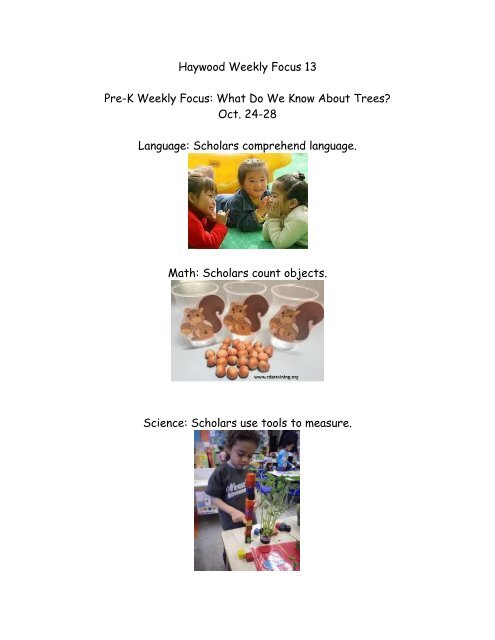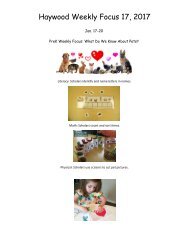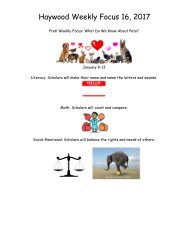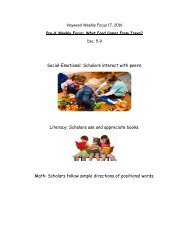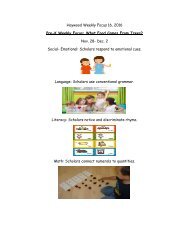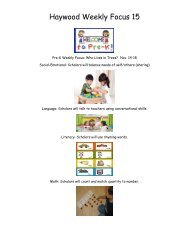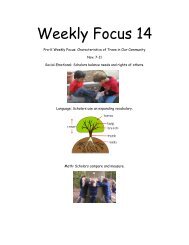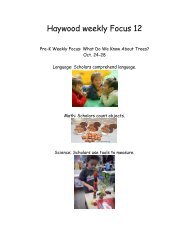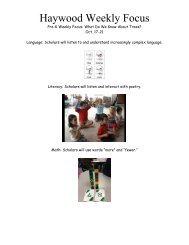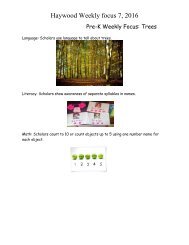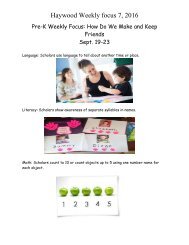weekly focus 13 2016
Create successful ePaper yourself
Turn your PDF publications into a flip-book with our unique Google optimized e-Paper software.
Haywood Weekly Focus <strong>13</strong><br />
Pre-K Weekly Focus: What Do We Know About Trees?<br />
Oct. 24-28<br />
Language: Scholars comprehend language.<br />
Math: Scholars count objects.<br />
Science: Scholars use tools to measure.
Subject Kindergarten Weekly Focus October 31-Nov 4<br />
RLA Scholars will isolate and pronounce the initial, medial vowel, and final sounds (phonemes) in CVC<br />
words.<br />
Scholars will use a combination of drawing, dictating, and writing to narrate a single event or several<br />
loosely linked events.<br />
L.K.2c –Write a letter or letters for most consonant and short vowel sounds.<br />
SL.K.3- Ask and answer questions in order to seek help, get information, or clarify something that is not<br />
understood.<br />
SL.K.2- Confirm understanding of a text read aloud or information presented orally or through other<br />
media by asking and answering questions about key details and requesting clarification if something is<br />
not understood. (confirm, clarify, media)<br />
RI.K.4- With prompting and support, ask and answer questions about unknown words in a text.<br />
RF.K.2d- Isolate and pronounce the initial media vowel, and final sounds (phonemes) in CVC words.<br />
W.K.2 – Use a combination of drawing, dictating, and writing to narrate a single event or several loosely<br />
linked events, tell about the events in the order in which they occurred, and provide a reaction to what<br />
happened. (narrate, event, sequence of events).<br />
Activities for home: Practice reading sight words, letter names, and sounds. Practice writing and<br />
drawing about books read at home. READ, READ, READ!
Math<br />
Scholars will correctly name shapes regardless of the orientations or overall size (circle, square,<br />
triangle, rectangle, trapezoid, hexagon).<br />
Social<br />
Studies<br />
K.G.A.2 Correctly name shapes regardless of the orientations or overall size (circle, square, triangle,<br />
rectangle, trapezoid, hexagon).<br />
K.CC.A.1- Count to 100 by ones and tens (0-40)<br />
K.MD.B.3- Classify objects into categories, count the number of objects in each category, and sort the<br />
categories by counting, (limit the category counts to be less than or equal to 5).<br />
Activities for home: Find and name shapes around the house. Practice writing and counting numbers 0-<br />
40.<br />
Scholars will identify and explain how the basic human needs of food, clothing, shelter, and<br />
transportation are met.<br />
Assessm<br />
ents<br />
K.6- Identify and explain how the basic human needs of food, clothing, shelter, and transportation are<br />
met.<br />
K.8- Explain why people work and recognize different types of jobs, including work done in the home,<br />
school, and community.<br />
Social Studies: Week 11<br />
Activities for home: Have conversations about the importance of basic human needs. Look through<br />
newspapers/magazines and find needs.<br />
-ELA- CVC words<br />
-Writing- sequence of events<br />
-Math- shape recognition and naming<br />
-Social Studies- wants and needs
Language Arts:<br />
Standards:<br />
*L.1.2d Use conventional spelling for<br />
words with common spelling patterns and<br />
for frequently occurring irregular words.<br />
*RI1.1 Ask and answer questions about<br />
key details in a text.<br />
*RI1.6 Distinguish between information<br />
provided by pictures or illustrations and<br />
information provided by the words in a<br />
text.<br />
* W.1.2 Write informative/explanatory<br />
texts in which they name a topic, supply<br />
some facts about the topic and provide<br />
some sense of closure.<br />
Objectives:<br />
*I can read and write words with<br />
short e by peeling off the word into<br />
individual letter sounds and pushing the<br />
sounds together quickly.<br />
*I can identify and use text and graphic<br />
features.<br />
* I can ask and answer questions as I read<br />
to help me understand what I read.<br />
*I can use text evidence to analyze and<br />
evaluate while reading.<br />
* I can write an informative text that<br />
names a topic and includes facts about<br />
that topic by using a thinking map to plan<br />
my writing.<br />
Journeys Lesson 9: Dr. Seuss<br />
Genres: Biography and Poetry<br />
Strategy: Question<br />
Skill: Text and Graphic Features<br />
Fluency: Accuracy: Word Recognition<br />
Vocabulary: Antonyms<br />
Writing: Informative<br />
Grammar: Singular and Plural Nouns<br />
Word Study: yes, let, red, ten, bed, get<br />
High Frequency Words: after, read,<br />
draw, was, pictures, write<br />
Mathematics:
Unit 5: Addition and Subtraction Using<br />
Place Value<br />
Go Math 6.3 Understand Tens and Ones<br />
Standard: 1.NBT.B.2b Understand that<br />
two digits of a two digit number represent<br />
amounts of tens and one. Understand the<br />
following as special cases: The numbers<br />
from 11-19 are composed of a ten and<br />
one, two, three, four, five, six, seven,<br />
eight, or nine ones.<br />
Objective: I can use models and write to<br />
represent equivalent forms of tens and<br />
ones by working with a partner to model<br />
how I can use different write a number as<br />
tens and ones.<br />
Go Math 6.4 Make Tens and Ones<br />
Standard: 1.NBT.B.2b Understand that<br />
two digits of a two digit number represent<br />
amounts of tens and one. Understand the<br />
following as special cases: The numbers<br />
from 11-19 are composed of a ten and<br />
one, two, three, four, five, six, seven,<br />
eight, or nine ones.<br />
Objective: I can use objects, pictures, and<br />
numbers to represent a ten and some<br />
ones by drawing a picture and writing to<br />
explain.<br />
1 ten and 2 ones<br />
10 + 2<br />
12<br />
1 ten and 3 ones<br />
10 + 3<br />
<strong>13</strong>
Science: Weather Unit<br />
Standard:<br />
*GLE 0107.8.1 Gather and interpret<br />
daily weather data.<br />
Objective:<br />
*I can gather and interpret daily<br />
weather data by looking outside<br />
and using sentence frames:<br />
It is _____ (hot/warm/cold) outside.<br />
There is ________________<br />
(strong wind, some wind, no wind).<br />
It is _____________________<br />
(foggy, cloudy/clear).<br />
There is _________________<br />
(no precipitation, rain, hail, snow).
Social Studies:<br />
Unit 4: Our Country- The United States of<br />
America<br />
*Standard:<br />
1.17 Identify the shapes of Tennessee and the<br />
United States on maps and globes.<br />
Objective:<br />
I can identify the shape of the United States<br />
and the shape of Tennessee on maps and<br />
globes.<br />
*Standard:<br />
1.19 Locate Washington D.C. and Nashville on<br />
a United States map.<br />
Objective:<br />
I can locate Washington D.C. on a United<br />
States map.<br />
*Standard:<br />
1.20 Distinguish the difference between a<br />
continent, mountain, river, lake, and ocean.<br />
Objective:<br />
I can distinguish the difference between a<br />
continent, mountain, river, lake, and ocean.<br />
*Standard:<br />
1.22 Construct a map showing the Atlantic<br />
Ocean, Pacific Ocean, Washington DC,<br />
Memphis, Nashville, Knoxville, Chattanooga,<br />
Mississippi River, Cumberland River,<br />
Tennessee River, Great Smokey Mountains,<br />
Rocky Mountains, Center Hill Lake, Norris<br />
Lake, Reel Foot Lake, and Clingman’s Dome.<br />
1.24 Summarize in their own words that a map<br />
is a representation of a space, such as the<br />
classroom, the school, the neighborhood,<br />
town, city, state, country, or world.
2 nd Grade<br />
“The Goat in the Rug”<br />
Essential Question- How is art connected to the past?<br />
Phonics<br />
y, ly, ful<br />
Topic Standards I Can…<br />
RF.2.3d Decode words with<br />
prefixes and suffixes.<br />
I Can……<br />
Connect sounds to writing.<br />
.
Comprehension<br />
Drawing Conclusions<br />
Sequence of events<br />
RL.2.7 Use information from<br />
illustrations and words to<br />
demonstrate understanding of<br />
character, set, or plot.<br />
RL.2.2 recount stories and<br />
determine their message,<br />
lesson, or moral.<br />
I can re-tell the structure of the<br />
story and talk about character,<br />
setting, and plot.<br />
I can locate text evidence and<br />
draw a conclusion to better<br />
understand the story.
Vocabulary<br />
L.2.4d Use knowledge of<br />
individual words to predict<br />
meaning of compound words.<br />
Use a glossary to apply<br />
vocabulary knowledge.<br />
I can explain the meaning of the<br />
following words: yarn, strands,<br />
spinning, dye, weave, sharpening,<br />
duplicated, and delicious.
Grammar<br />
Irregular Verbs<br />
L.2.1 Demonstrate command of<br />
the conventions of standard<br />
English grammar and usage<br />
when writing or speaking.<br />
I can identify when to use irregular<br />
verbs have, has, and had.
Writing<br />
Opinion Writing<br />
W.2.1 Write opinion pieces in<br />
which they introduce the topic<br />
or book they are writing about,<br />
state an opinion, supply reasons<br />
that support the opinion, using<br />
linking words (i.e because, and,<br />
also) to connect opinion and<br />
reasons, and provide a<br />
concluding statement or section.<br />
I can identify an opinion about the<br />
text or topic.<br />
I can produce and identify at least<br />
two supporting reasons for the<br />
opinion.<br />
Math<br />
2.NBT.B.5 Fluently add and<br />
subtract within 100 using<br />
strategies based on place value,<br />
properties, and/or the<br />
relationship between addition<br />
and subtraction.<br />
2.NBT.B.9 Explain why addition<br />
and subtraction strategies work,<br />
using place value and the<br />
properties of operations.<br />
(Explanations may be supported<br />
by drawings or objects.)<br />
Adding and Subtracting Tens<br />
and Ones<br />
Lessons 4.5, 4.6, 4.7,<br />
5.4, 5.5<br />
Assess after 4.7<br />
Assess after 5.5<br />
Use base ten blocks<br />
Base ten pictures<br />
T-chart<br />
Written explanations<br />
http://www.k-<br />
5mathteachingresources.com<br />
/
Science<br />
Solar System<br />
Earth and Its Place in the Universe<br />
2.7.1a | 2.7.1b | 2.7.2a | 2.7.2b<br />
1. Use observations or models of<br />
the sun, moon, and stars to<br />
describe patterns that can be<br />
predicted.<br />
2. Analyze data to predict<br />
patterns between sunrise and<br />
sunset.
Subject<br />
ELA<br />
3 rd Grade Weekly Focus October 31 – Nov 4, <strong>2016</strong><br />
Weekly Skills to Practice<br />
This week in 3 rd grade, students will work on asking and answering questions in a text.<br />
With this strategy they will be able to apply it to the skill of cause (why something<br />
happens) and effect (what happens) in a given text. They will be using multi-flow<br />
thinking maps to help them master this skill.<br />
Comprehension Skill/Strategy:<br />
Reading Focus:<br />
Standards:<br />
RL.3.9 Compare and contrast the themes, settings, and plots of stories written by the<br />
same author about the same or similar characters (e.g., in books from a series).<br />
Academic Vocabulary: compare, contrast<br />
RL.3.3 Describe characters in a story (e.g., their traits, motivations, or feelings) and explain how<br />
their actions contribute to the sequence of events.<br />
Academic Vocabulary: interaction, motivation, sequence of events, traits<br />
SL.3.1a- Come to discussions prepared, having read or studied required material; explicitly<br />
draw on that preparation and other information known about the topic to explore ideas<br />
under discussion.<br />
RL.3.1- Ask and answer questions to demonstrate understanding of a text, referring explicitly<br />
to the text as a basis for answers.<br />
Writing Focus:<br />
Standard: W.3.1 Opinion Writing Students will create opinion pieces on topics that support<br />
point of views with reason.<br />
Vocabulary Focus: (Social Studies)- Memphis, monument, governor, constitution, legislative,<br />
judicial, executive, Bill of Rights, Mississippi River, Limestone<br />
Vocabulary Focus: Prefixes un- and mis-
Standards:<br />
W.3.1 -Write opinion pieces on topics or texts, supporting a point of view with reasons.<br />
L.3.2c- Use commas and quotation marks in dialogue.<br />
Additionally, students should be reading for 20 minutes each night. They should be<br />
recording what they are reading in their agenda nightly.<br />
Additionally, students should be reading for<br />
20 minutes each night. They should be<br />
recording what they are reading in their<br />
agenda nightly.<br />
Social<br />
Studies<br />
Students will continue studying North America while <strong>focus</strong>ing specifically on Tennessee.<br />
Students will identify and distinguish Tennessee landforms, climates, and population. Students<br />
will also work towards learning more about major cities found in Tennessee.<br />
Main <strong>focus</strong> this week will be West Tennessee from Week 8 in Studies Weekly.<br />
Standards: 3.27 Compare and contrast landforms, climates, population, natural resources,<br />
and major cities of the three Grand Divisions of Tennessee. (East – Smokey Mountains and the<br />
Cumberland Plateau, Middle-the Highlands, West – the Lowlands)
Sciencep o<br />
Standard: SCI.3.GLE 0307.7: The Earth: Major geologic events that occur<br />
over eons or brief moments in time continually shape and reshape the surface of the<br />
Earth, resulting in continuous global change.<br />
Objective: SCI.3.: How is the earth affected by long-term and short term geological<br />
cycles and the influence of man?<br />
<br />
<br />
<br />
SCI.3.GLE 0307.7.2: Recognize that rocks can be composed<br />
of one or more minerals. Describe how rocks can be classified according to their<br />
physical characteristics.(SPI)(K)<br />
SCI.3.GLE 0307.7.3: Distinguish between natural and<br />
manmade objects.<br />
SCI.3.GLE 0307.7.4: Design a simple investigation to<br />
demonstrate how earth materials can be conserved or recycled.<br />
Vocabulary<br />
Rock cycle Sedimentary Igneous metamorphic<br />
Math<br />
Standards: 3.MD.D.8 Solve real world and mathematical problems involving perimeters of<br />
polygons, including finding the perimeter given the side lengths, finding an unknown side<br />
length, and exhibiting rectangles with the same perimeter and different areas or with the<br />
same area and different perimeters.<br />
Objective: I can find the perimeter of polygons with unknown side length using<br />
real world applications.<br />
<br />
<br />
<br />
<br />
Understanding?<br />
A polygon is a closed shape with straight sides.<br />
Quadrilaterals are shapes with four sides and four angles.<br />
Area is the amount of space inside a shape.<br />
Perimeter is the distance around the edge of a two-
Academic Vocabulary<br />
Polygon<br />
Area<br />
Perimeter<br />
What is the perimeter of this<br />
pentagon?<br />
Area = 10 square<br />
units 2+2+2+2+2=1<br />
0<br />
Perimeter= distance around the figure.<br />
Perimeter = 4+4+10+12+4+2+1+2<br />
Perimeter = 39<br />
Additionally: Students need to be<br />
practicing multiplication facts daily.<br />
They have been given multiplication cards for home practice.
Computer<br />
Resources<br />
News You<br />
can Use<br />
BrainPop Jr.<br />
www.brainpopjr.com<br />
Username: eaglet<br />
Password: eaglet<br />
Upcoming Dates to Remember:<br />
<br />
Flocabulary<br />
www.flocabulary.com<br />
Username: westmiddlestudent4<br />
Password: westmiddlestudent4<br />
Khan Academy<br />
Learn Zillion<br />
Haywood’s Book Fair is Oct. 27th-Nov. 4th: Look for a flyer from Mrs.<br />
Mitchell later this month!<br />
<br />
<br />
<br />
Haywood t-shirts are available for you to buy for $10 cash every Friday<br />
from 7:30 – 8:00 in the gym by the PTO!<br />
November 8 th Parent Teacher Conference day. Students will not report<br />
to school.<br />
November 11 th is the third grade field trip to see Children’s Theater<br />
production of “Junie B Jones”. Don’t forget to return your signed<br />
permission slip and $8.
4 th Grades Weekly Focus October 31 st to Nov. 4th<br />
Unit 2: Jose Born to Dance: October 31st-November 4th<br />
Poetry: Dance to the Beat<br />
Weekly Focus<br />
I can identify the theme of a text. I can compare and contrast two different genres on the<br />
same topic.<br />
Essential Question: What Does it Take to be a Great Performer?<br />
Foundations<br />
CCSS.ELA-Literacy.L.4.2.d<br />
Spell grade-appropriate words<br />
correctly, consulting references as<br />
needed.<br />
Determine the meaning of<br />
academic vocabulary, words,<br />
and phrases.<br />
Standards<br />
Comprehension Strategies/Skills<br />
Compare/contrast poems, drama and prose, while using academic<br />
vocabulary, words, and phrases<br />
Grammar and Writing<br />
Opinion Writing<br />
Develop opinion piece of<br />
writing through Writer’s<br />
workshop. Develop<br />
informational/explanatory<br />
piece of writing through<br />
writer’s workshop.<br />
SmartBoard lessons, Anchor<br />
Charts, Thinking Maps<br />
CCSS.ELA-Literacy.L.4.2.a<br />
Use correct capitalization.<br />
CCSS.ELA-Literacy.L.4.3.a<br />
Choose words and phrases to<br />
convey ideas precisely.*
Vocabulary: Metaphor,<br />
Figurative language,<br />
simile,<br />
CCSS.ELA-Literacy.RL.4.3<br />
Describe in depth a character, setting, or event in a story or drama, drawing<br />
on specific details in the text (e.g., a character's thoughts, words, or actions).<br />
CCSS.ELA-Literacy.RL.4.4<br />
Determine the meaning of<br />
words and phrases as they<br />
are used in a text, including<br />
those that allude to<br />
significant characters found<br />
in mythology (e.g.,<br />
Herculean).<br />
Supplemental Literature<br />
War for<br />
Independence<br />
(1760-1789)<br />
Song and Dance Man by Patricia Polacco (dance, simile, metaphor)<br />
Social Studies<br />
SmartBoards lessons, Thinkpads, projects,<br />
interactive timeline, Readworks, informational text<br />
structures, thinking maps<br />
http://www.readworks.org/passages/colo<br />
nization-revolutionary-war-introductionrevolutionary-war<br />
Revolutionary War 1764 - Taxes<br />
http://www.readworks.org/passages/colonizati<br />
on-revolutionary-war-declarationindependence<br />
Revolutionary War 1775 –( George<br />
Washington)<br />
http://www.readworks.org/passages/colonizati<br />
on-revolutionary-war-valley-forge<br />
Revolutionary War 1777 – Valley Forge<br />
Supplementary literature - Revolutionary War<br />
on Wednesday #22 Magic tree House<br />
CCSS.ELA-Literacy.RI.4.3<br />
Explain events, procedures,<br />
ideas, or concepts in a<br />
historical, scientific, or<br />
technical text, including what<br />
happened and why, based on<br />
specific information in the<br />
text.<br />
CCSS.ELA-Literacy.RI.4.5<br />
Describe the overall structure<br />
(e.g., chronology, comparison,<br />
cause/effect, problem/solution)<br />
of events, ideas, concepts, or<br />
information in a text or part of a<br />
text.<br />
CCSS.ELA-Literacy.RI.4.6<br />
Compare and contrast a firsthand<br />
and secondhand account of the<br />
same event or topic; describe the<br />
differences in <strong>focus</strong> and the<br />
information provided.<br />
Math
I can divide large numbers using multiple strategies.<br />
I can explain my strategies and reasoning behind them.<br />
Essential questions<br />
How can we use multiplicative comparisons to divide?<br />
How can we use number sense and place value to divide?<br />
Vocabulary<br />
Quotient, dividend, divisor, remainder, factor, multiple<br />
Number Talks
Science<br />
Unit- Ecosystem Interactions<br />
Focus Standard<br />
SPI 0407.3.1<br />
Determine how different organisms function within an environment in terms of their location<br />
on an energy pyramid.<br />
SPI 0407.5.1<br />
Determine how a physical or behavioral adaptation can enhance the chances of survival.<br />
SPI 0407.5.2<br />
Infer the possible reasons why a species became extinct or endangered.<br />
Guiding Question:<br />
How do living things interact with one another and with the nonliving<br />
elements of their environment?
Vocabulary<br />
Hibernate, Camouflage, Mimicry,<br />
Migration, Locomotion, Stimulus,<br />
Tropism, Environmental Changes,<br />
Endangered, Extinction, Fossil,<br />
Interdependency, Competition,<br />
Predation, Physical Adaptations,<br />
Behavioral Adaptations, Ecosystem,<br />
Consumer, Producer, Energy Pyramid,<br />
Food Web, Biotic, Abiotic, Omnivore,<br />
Carnivore, Herbivore<br />
Check 0407.2.2<br />
Design a simple experiment to illustrate the effects of competition, predation, and<br />
interdependency among living things.<br />
Around Our School – Biotic and Abiotic Components<br />
Create an Ecosystem Model, Ecosystem in a Jar 1,2<br />
Create a classroom/school garden 1<br />
Investigate Life Cycle of a plant<br />
Daily Science Journal Observations – KWL Graphic Organizer<br />
…What would happen if…../Ecosystem Role play
Check 0407.3.1<br />
Create a food web that illustrates the energy relationships between plants and animals and the key<br />
issues or assumptions found in the model.<br />
What Do I Eat?/classify producers, consumers, carnivores, herbivores and<br />
omnivores3<br />
Food Webs vs. Food Chains (Opened and Closed Sorts)1,2,3,4<br />
Create an interactive food web that illustrates the energy relationship<br />
between plants and animals and the key issues or assumptions found in the<br />
model 3, 4<br />
Create an energy pyramid 2, 4<br />
Debate extinct elements and support arguments of cause/effect<br />
Informative/Explanatory writing piece<br />
GLE 0407.5.1<br />
Analyze physical and behavioral adaptations that enable organisms to survive in their environment.<br />
Informative Texts<br />
Analyze characteristics of animals in different environments<br />
Create an animal to live in a specific environment and write a narrative story<br />
about the environment and created animal3,6<br />
Stellar Sea Lion improve on adaptations<br />
Human adaptations discussion<br />
Bird beak reading3<br />
Bird beak experiment3,5,6<br />
GLE 0407.5.2<br />
Describe how environmental changes caused the extinction of various plant and animal species.<br />
SPI 0407.4.1<br />
Draw conclusions about the relationship between reproduction and the survival of a species.<br />
Research extinct animals and plants to discover causes of extinction3<br />
Create informative newspaper article about extinction of a species3<br />
Role play about extinct animals3<br />
SPI 0407.4.2<br />
Distinguish between complete and incomplete metamorphosis.<br />
Informative texts<br />
Examination of metamorphosis<br />
Creation of incomplete and complete metamorphic cycles<br />
Venn Diagram of incomplete and complete<br />
Students create songs about complete and incomplete metamorphosis
Resources<br />
Resources:<br />
Brain Pop<br />
Study Jams Science<br />
Picture Perfect Science<br />
Bill Nye Food Webs<br />
Bird Beak Website<br />
Bird Beak Experiment<br />
Butterfly Metamorphsis<br />
https://k12mnpsmy.sharepoint.com/personal/kknight_mnps_org/_layouts/15/guestaccess.aspx?guestaccesstoken=9C8a<br />
HPjlEoG0lvV7zd3bAQVwDDeDHR3tErQPSTRfcJA%3d&docid=107930b8b3b084040adef116c53c2f1<br />
d0&rev=1


